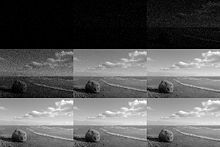


Eigengrau (German for "intrinsic gray"; pronounced [ˈʔaɪ̯gŋ̍ˌgʁaʊ̯] ), also called Eigenlicht (Dutch and German for "intrinsic light"), dark light, or brain gray, is the uniform dark gray background color that many people report seeing in the absence of light. The term Eigenlicht dates back to the nineteenth century,[1] and has rarely been used in recent scientific publications. Common scientific terms for the phenomenon include "visual noise" or "background adaptation". These terms arise due to the perception of an ever-changing field of tiny black and white dots seen in the phenomenon.[2]
Eigengrau is perceived as lighter than a black object in normal lighting conditions, because contrast is more important to the visual system than absolute brightness.[3] For example, the night sky looks darker than Eigengrau because of the contrast provided by the stars.
Contrast threshold data, collected by Blackwell[4] and plotted by Crumey, shows Eigengrau occurring at adaptation luminances below approximately 10− 5 cd m−2 (25.08 mag arcsec−2).[5] This is a limiting case of Ricco's law.
- ^ Ladd, Trumbull (1894). "Direct control of the retinal field". Psychological Review. 1 (4): 351–55. doi:10.1037/h0068980.
- ^ Hansen RM, Fulton AB (January 2000). "Background adaptation in children with a history of mild retinopathy of prematurity". Invest. Ophthalmol. Vis. Sci. 41 (1): 320–24. PMID 10634637.
- ^ Wallach, Hans (1948). "Brightness Constancy and the Nature of Achromatic Colors". Journal of Experimental Psychology. 38 (3): 310–24. doi:10.1037/h0053804. PMID 18865234.
- ^ BLACKWELL HR (1946). "H. Richard Blackwell, Contrast Thresholds of the Human Eye. Journal of the Optical Society of America Vol. 36, Issue 11, pp. 624-643 (1946)". Journal of the Optical Society of America. 36 (11): 624–643. doi:10.1364/JOSA.36.000624. PMID 20274431.
- ^ Crumey, Andrew (2014). "Human contrast threshold and astronomical visibility". Monthly Notices of the Royal Astronomical Society. 442 (3): 2600–2619. arXiv:1405.4209. doi:10.1093/mnras/stu992.